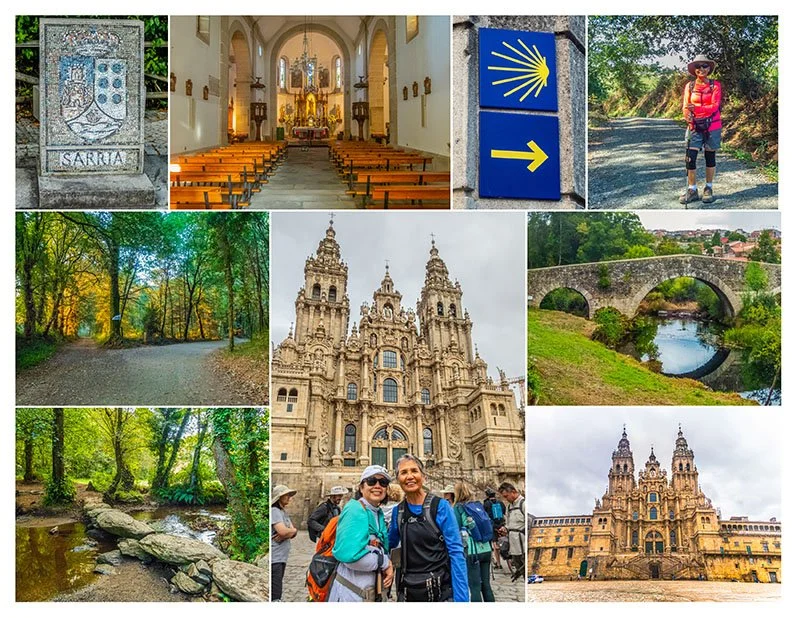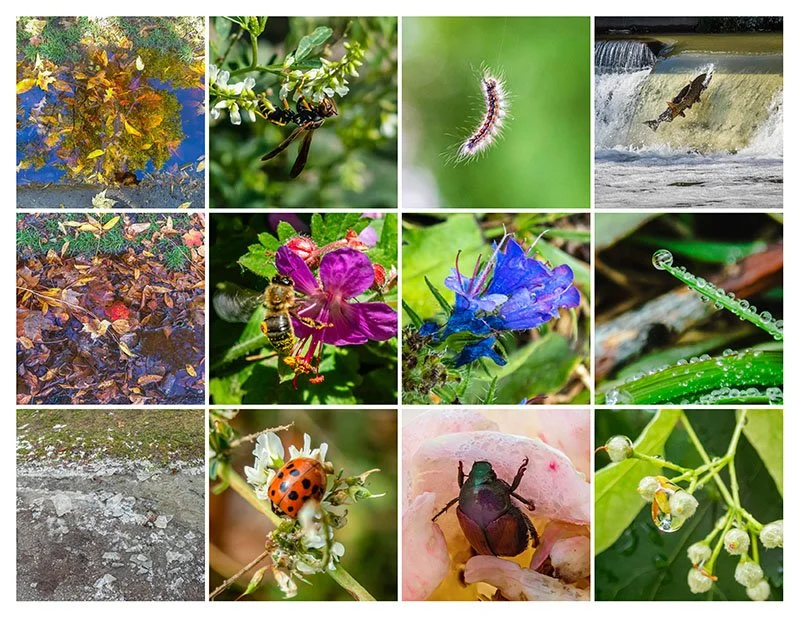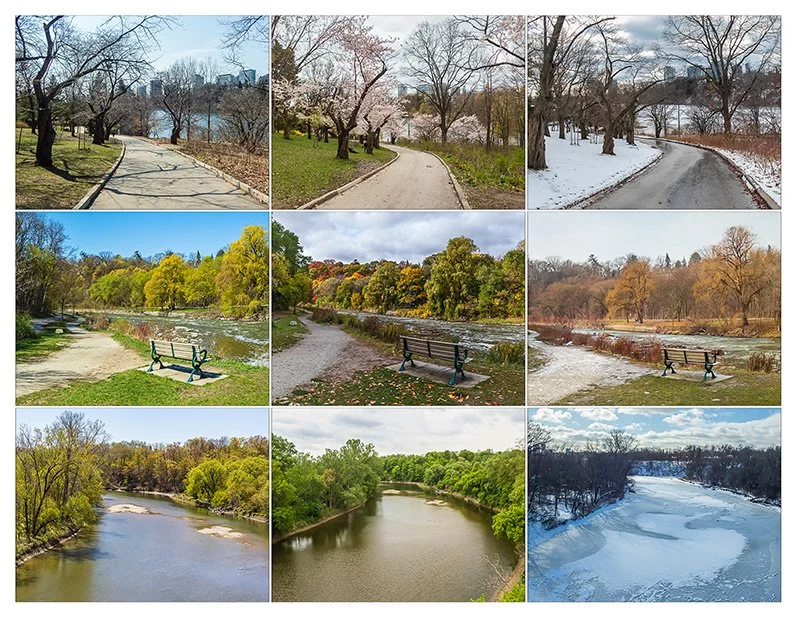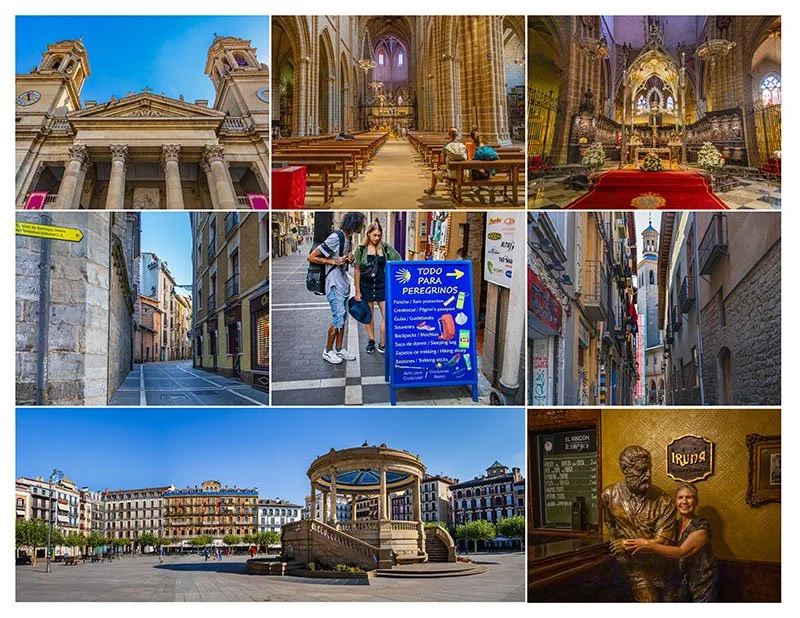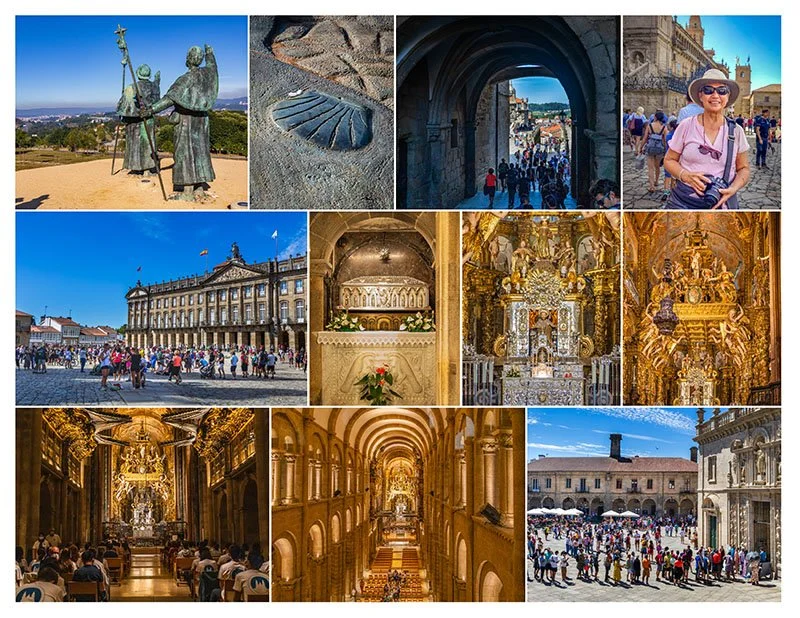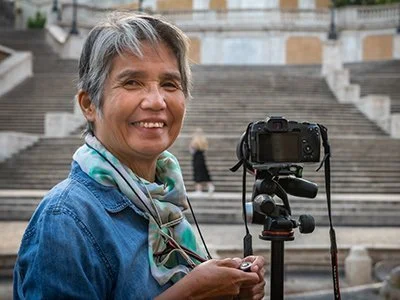From Blisters to Blessings: Walking Back to Santiago
/During the six days we hiked, I told God every little thing in my heart and thanked Him for everything, including the lessons that I had taken so long to learn and had accepted begrudgingly. More than anything else, I asked and begged Him, and begged again, for a baby for Tanya, my one precious little girl, my youngest child. By that time, I already had two adolescent granddaughters from two of my sons.
The endless, lonely stretches of rural Galicia made room for the soles to feed the soul, the feet to work with faith, the blisters to turn to blessings. I don’t have the proper words to describe how I felt when we reached Santiago and joined the crowd that buzzed with positive energy. There’s a certain feeling you get when you are in a sacred place. I felt that way in Santiago and I knew I wanted to do a Camino again.
Scenes from my Camino in 2019.
Top row, first two photos: My friend Nadja and I started in the town of Sarria at the Iglesia de Sta. Mariña where we attended Mass and got the first stamp on our Camino passports. We followed the yellow arrows until we reached the Cathedral of Santiago de Compostela (middle photo). Last photo: The Santiago Cathedral one early, rainy morning before the rush of pilgrims. (Photos by Odette Foronda)
Toronto
Three weeks after I returned home to Toronto, I got news that Tanya was expecting twins. Twins! God had said no to my plea. No, no, no, not one baby; how about two?
I couldn’t contain my joy and wanted to run back to Santiago to say thank you. I knew that it was not the hiking per se, not even the place. The presence of Santiago’s remains in the cathedral has no scientific proof but is based on a mix of fact and legend. But if pilgrims had walked the Camino for at least a thousand years and had come back enlightened, God must have honored their collective faith by sanctifying the path and blessing each pilgrim who approaches with a faithful heart.
The twins were due in May 2020. Being then retired, I was all set to go to Evanston (in Chicagoland) to welcome them and live with their family for six months on diaper-change duty. When I was done with that, I was thinking I could do a thank-you trip to Santiago in 2021, a Compostela Holy Year, maybe on another Camino or just a simple visit. During a Compostela Holy Year, the Catholic Church grants universal forgiveness to those who make the pilgrimage to Santiago. To signify this, a special door to the cathedral is opened the entire year. (It is cemented off on other years.)
Now, we all remember what happened on March 11, 2020: the Covid-19 pandemic. In a matter of days, the US-Canada border was closed. I told myself that maybe, by May, things would be back to normal and I’d make it to Evanston in time to welcome the twins.
I was dead wrong, of course. To make things worse, the twins decided to come out in mid-April, a mere month after the pandemic was declared. What if mom and babies got Covid in the hospital? Being preemies, the infant boys needed to stay in NICU. Adrian, the older and bigger one, was there for two weeks. Gabriel was tinier and could not feed nor properly breathe on his own and needed to stay in the NICU for a full month. I helplessly watched videos and photos of him with tubes in his nose and tapes on his tiny, pink body. Any grandma who has to look at something like that would want to run and be with her daughter and her fragile infants. The Covid pandemic deprived me of all that.
Thank God for video chats, I saw the twins almost every day. I prayed hard for them, attending Pope Francis’ daily Masses remotely from home in Toronto. We had strict lockdowns, and I mostly stayed home in the first two months. After realizing that I had put on my own Quarantine Fifteen pounds, I ventured out of my small condo box and did a slower version of the training routine that I had done to prep for the Camino months earlier.
While half of my social media friends were learning how to make sourdough bread, I was staring at buds, wildflowers, weeds, raindrops, ice fractals. I looked for pretty things on rain puddles, mud puddles, icy puddles. I learned about catkins and leaf galls and plant names. I birdwatched and salmon-watched, counting how many of them made the jump over a low dam when they swam upstream in the fall.
Scenes from my Covid lockdown walks in Toronto, 2020-2021.
Leftmost column: photos of puddles on the same spot taken at different times of the year
Top right photo: two salmon jumping in sync over a dam at Humber River
The rest of the photos: wildflowers, weeds, and bugs on the trail. (Photos by Odette Foronda)
More scenes from my Covid lockdown walks, Toronto, 2020-2021.
Top row: Cherry Lane at High Park in early spring, mid-spring, and winter
Middle row: Humber River Trail, the one I frequented the most, in spring, fall, and late fall when the
first snows came
Bottom row: Humber River in spring, summer, and mid-winter. (Photos by Odette Foronda)
I walked and walked and walked, almost dying of gigil, picturing the babies’ tiny pink cheeks and shining, innocent eyes. (Gigil, a Tagalog word with no direct counterpart in English, is an overwhelming urge to do something. In this case, it’s to squeeze the babies.)
My twin grandsons at six months: Adrian, on the left, is a mini-dad; Gabriel is a mini-mom.
(Photo by Audrey Hoover)
Evanston
In mid-2021, the longest fifteen months of my life ended after I received my second Covid vaccine shot and could finally fly to Chicago. I met the twins for the first time when they were already fifteen months old. They took to me quickly, I guess because they simply knew from my touch that I am someone with whom they could be safe. I soon got into the groove of feeding, playing, cleaning poopy butts, and taking them on daily walks in a park by Lake Michigan. Because the double stroller caught many people’s eyes, some regular walkers became my friends. One day, my son-in-law, Joe, walked his twins to the park. A lady stranger stopped him to look at the babies and quickly said, “Oh, these are Odette’s grandkids!”
Scenes from my Evanston walks, 2020-2021.
Top row: I walked the twins almost daily to Arrington Lagoon, which we called the duckie pond. Middle photo: Gabriel in the top seat, Adrian below, one fall morning after we fed the ducks.
Middle row: The same tree with different looks.
Bottom row: A spot on the trail by Lake Michigan, also sporting different looks. (Photos by Odette Foronda)
I returned home in late January 2022, and the twins were sent to daycare. By then, they were almost two years old. As many parents say, kids will pick up all sorts of bugs at daycare and before long, one of the twins got sick. So, this grandma went running to Evanston to help care for both babies, because once one gets sick, you can be sure the other will shortly follow. Since then, I have been practically on call. As in, I learn one morning that one or both babies are sick and I’m on a plane to Chicago in the afternoon or the next day. I call it saklola duty, a job I wouldn’t trade for anything. (Saklola: a play on the Tagalog words for rescue and grandma.)
The time came when most travel restrictions were eased, and I went into a trip-planning frenzy with my friends. When I learned that, because of the pandemic, Pope Francis had extended the 2021 Compostela Holy Year to 2022, I knew it was time to go back to Santiago. My friends and I had a long wish list, but I told them that on top of our plans, I was going to Santiago solo if none of them wanted to come along. Everyone was in, but it was not to be a Camino. That was fine. To compensate, I inserted two major Camino Francés locations into our itinerary: Saint Jean-Pied-de-Port and Pamplona.
Saint-Jean-Pied-de-Port
Medieval pilgrims used to walk from their homes in Europe to Santiago de Compostela, and then walk back home, with the trip taking several months. If they were not coming from the Iberian Peninsula, they needed to cross the mighty Pyrenees in order to reach Spain. The Basque town of Saint-Jean-Pied-de-Port on the foothills of the Pyrenees was a good place to rest and regroup before the arduous climb over the mountains and onto Spain. The 790-kilometer route that starts in this French town has come to be known as the Camino Francés. Of the many pilgrimage routes to Santiago, Camino Francés is the most popular. This is the Camino that Nadja and I followed in 2019, but we did only the tail-end of it in the Spanish province of Galicia.
In 2022, my friends and I spent a few hours walking around pretty Saint-Jean-Pied-de-Port. Like several other Camino towns I’ve visited outside of the Camino Francés, it’s got the familiar, welcoming feel I call the pilgrim vibe. You can’t go wrong with the mountain setting, either.
Scenes from Saint-Jean-Pied-de-Port, France, 2022. On the Pyrenean foothills, Saint-Jean-Pied-de-Port is the town where the 790-kilometer Camino Francés starts.
Top row, middle: Saint James Gate, the historic entrance for pilgrims, is a UNESCO World Heritage site.
Middle and bottom right photos: The 13th century Notre Dame Church where many pilgrims pray before heading out on their Camino.
Bottom middle: An elderly lone pilgrim talking to a local. (Photos by Odette Foronda)
More scenes from Saint-Jean-Pied-de-Port, France, 2022.
The iconic bridge is steps away from the door of Notre Dame Church and is on Rue d’Espagne, the road that leads to Spain. The Camino arrow points to Roncesvaux (Roncesvalles), the traditional first pilgrim stop in Spain. Candle offerings at the Notre Dame Church. A scene along a road on the Pyrenees just outside of St Jean. (Photos by Odette Foronda)
Pamplona
Seventy-five kilometers from Saint-Jean-Pied-de-Port, Pamplona is four or five days away for the average pilgrim and 28-30 days to Santiago. Many pilgrims who need a break from the climb over the Pyrenees find Pamplona a great place to stay an extra day or two.
The name Pamplona derives from Pompaleo, which was founded by Roman general Pompey around 75 BC when he used it as his headquarters. Before Pompey, however, there were the Vascones, a pre-Roman tribe who had their chief town in the same location, a town they called Iruña. Today, the city is called Pamplona in Spanish and Iruña in Basque.
Pamplona, Spain, 2022.
Top row: The 14th century Catedral de Pamplona, where many pilgrims stop and pray.
Middle row: Many streets, like these ones, are marked with the yellow Camino arrow. Because Pamplona is a major stop on the Camino Francés, it has several pilgrim-supply stores (middle).
Bottom left: Plaza del Castillo is the town’s main square. On one side, toward the middle of the photo, is Café Iruña, where Ernest Hemingway loved to hang out. Bottom right: me hugging Papa Hemingway’s statue inside Café Iruña. (Photos by Odette Foronda)
The Camino aside, we cannot go to Pamplona without taking a closer look at the world-famous running of the bulls, as well as at my writing idol Papa Hemingway who made the town and the event famous in his novel The Sun Also Rises.
The bull run, or encierro in Spanish, dates back to the Middle Ages and is a highlight of the July festival to honor San Fermin, the town’s patron saint. It used to be done only on July 7, but now the festival is a week-long affair with daily encierros.
During the festival, about a million people pack the town for fun, food, booze, music, and general merriment – apart, of course, from participating in or watching the bull run. The runners, who traditionally wear white with red bandanas, first chant before an image of San Fermin to pray for his guidance and blessing during the bull run. Then they position themselves along the 850-meter route from the bull pen to the bull ring on the town’s narrow cobbled streets. They start running in front of the bulls as the beasts approach. The route is fenced off to keep man and beast in check. All the upper-floor balconies along the route are packed with sangria-guzzling, screaming crowds. Besides being narrow, the streets on the route are sloping and have dangerous curves. To top it all, the entrance gate to the bull ring is a serious bottleneck where runners can literally pile on top of each other. In less than three minutes, the whole thing is over.
People have been gored, for sure, runners and spectators alike. Has anyone died? Yes to that, too. And the bulls? The poor beasts will be part of the day’s bullfights, meaning they will all inevitably die by day’s end.
Why then? Don’t they know that they don’t have to do it? Well, there’s a crazy element to the Spanish spirit, and it sometimes comes to the fore, with the encierro being one shining instance.
Pamplona Bullrun Route, 2022.
Top row, from left: If you are a bull, you start in the bullpen and wait for the gate to fling open onto Calle Santo Domingo. If you’re human, you pray before the niche of San Fermin, 100 meters from the bullpen, and start running when the bulls approach. On the wall next to San Fermin’s statue is a red sign that marks the bull run’s route; there’s a mirror next to it because the road curves up from the bullpen. Calle Santo Domingo slopes up from the bullpen; the direction of the run is to the left.
Middle row and bottom row, left: Streets along the bull run route. The leftmost photo is of City Hall. The balconies lining the route are packed with spectators during a bull run.
Bottom row, middle photo: The entrance gate to the bullring, 850 meters from the bullpen. The Superman-clad figure has the face of Ernest Hemingway, whose bust is below it. Rightmost photo: Detail from the bronze monument Encierro a block away from the bull ring. (Photos by Odette Foronda)
Santiago de Compostela
On our short visit to Santiago, I invited my friends, none of whom had ever done a Camino, to walk the final five kilometers with me. We started at Monte do Gozo (Galician for hill of joy), a Camino milestone whose name refers to the joy the ancient pilgrims felt as they raced to the hilltop to have their first glimpse of the spires of the Santiago Cathedral. I wanted to feel the pilgrim’s excitement once again on the approach to Praza do Obradoiro that faces the cathedral, and I wanted my friends to get a sense of it, too, albeit from a micro-mini-Camino. Most of all, I wanted to say thank you to the Camino for the gift of the twins by leaving twin white pebbles that I had carried from home on Monte do Gozo.
The sorrow or burden stone is one of several rituals that Camino pilgrims perform. Traditionally, a pilgrim carries in his backpack a stone from home that signifies sorrows and burdens that he wants to surrender to God on his walk to Santiago. The most significant place to do this is at the foot of Cruz de Fierro, a giant iron cross on the highest point on the Camino in Léon province, some fourteen days to Santiago. We didn’t walk by this cross on our 2019 Camino, so at that time I chose to part with my sorrow stone at Monte do Gozo.
Other pilgrim traditions: Upon reaching Santiago, visit Santiago’s tomb in the Cathedral’s crypt, hug the saint’s statue, and attend a pilgrim’s Mass where the giant botafumeiro spreads incense as it is swung along the length of the cathedral’s nave. In 2019, we were only able to visit the tomb and take a peek at the back of the statue, because the cathedral was partly closed for renovation in preparation for the 2021 Holy Year.
On my second visit, I went down to pray at the tomb once more. I got a good view of the statue, but hugging it was not allowed because of Covid. The botafumeiro was not in use either. No matter. I was overcome with joy to set foot on Santiago once more. And because it was a Compostela Holy Year, the Holy Door was open and we all had a chance to enter the cathedral through it.
Last-5km Camino, 2022.
Top row, from left: Two pilgrim statues on Monte do Gozo point toward the spires of the Santiago Cathedral five kilometers away. The twin white thank-you stones that I left at Monte do Gozo. Pilgrims on their last few Camino steps as they approach Praza do Obradoiro for their first glimpse of the Santiago Cathedral’s magnificent façade. Me arriving from Monte do Gozo at Praza do Obradoiro.
Middle row: A section of the Praza do Obradoiro with mostly newly-arrived pilgrims. Inside the cathedral: the tomb of St. James, the statue of St. James, the giant botafumeiro (thurible or incense spreader).
Bottom row: Pilgrims attend Mass at the cathedral; overhead view of the central nave; pilgrims line up to enter the Holy Door. (Photos by Odette Foronda)
To absorb as much as I could of Santiago during our two days there, I tiptoed out of our hotel at night while my friends slept. Santiago did not disappoint, as you can see from the photos below which I took past midnight. At the Praza do Obradoiro, there was music, dancing, general chatter, happy faces. In Spain, it’s not only Madrid and Barcelona that never sleep; it’s Santiago, too.
Santiago past midnight, August 2022.
Left and middle column: Scenes from Praza do Obradoiro. Middle row, left and center: the crowd listens and dances to lively music by a band in colorful capes.
Top right: the cathedral’s clock tower lit up in blue with Ano Xacobeo 21/22, meaning Jacobean Year 21/22.
Bottom right: a street near the cathedral. (Photos by Odette Foronda)
A view of the Santiago Cathedral façade through an arch of the Palacio Rajoy on Praza do Obradoiro, August 2022 (Photo by Odette Foronda)
I am still on call as saklola. The twins, now four, remain a delight and are very rambunctious. Gabriel, who is more attached to me, says, “I very love you sometimes I cry,” meaning he misses me when I’m gone. Another time, he said, “I love you more than Mommy and Daddy.”
What’s a grandma to do? I follow the kids’ parents’ rules. But, between you and me, it’s for the most part. For the most part.
Adrian once noticed one of my toenails, thinking I had a boo-boo. I said it didn’t hurt and I was fine. I didn’t tell him that it’s a battle scar from my Camino, blackened from the pressure of constantly hitting the road. Almost five years later, it’s still half-dead. I also have calluses on my feet where blisters had once been. But they don’t bother me, because they’re a constant reminder of the time God said no. No, you’re not getting one grandchild; you’re getting two.
Thank You, dear God, thank You, for these two beautiful boys. How about we all come and visit You in Santiago one day?
Some photos of the twins who recently turned four.
Top left: with me on my 70th birthday.
Top right: Adrian on his third birthday. Middle right: Gabriel on his third birthday.
Bottom row, from left: Feeding the duckies; shooting the duckies as my photography apprentices; showing off their finds: three cicada shells and three roly-polies wrapped in tissue. (Photos by Odette Foronda)
Odette Foronda is a mother of four and grandma of four. Based in Toronto and now retired from years of working in the numbers field, she’ll travel as far as her Ilocano purse will allow. She publishes books of her travel photos and stories (https://www.blurb.com/user/odettef).
More articles from Odette Foronda


